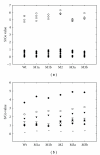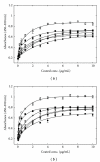Improving antigenicity of the recombinant hepatitis C virus core protein via random mutagenesis
- PMID: 21904443
- PMCID: PMC3166572
- DOI: 10.1155/2011/359042
Improving antigenicity of the recombinant hepatitis C virus core protein via random mutagenesis
Abstract
In order to enhance the sensitivity of diagnosis, a recombinant clone containing domain I of HCV core (amino acid residues 1 to 123) was subjected to random mutagenesis. Five mutants with higher sensitivity were obtained by colony screening of 616 mutants using reverse ELISA. Sequence analysis of these mutants revealed alterations focusing on W(84), P(95), P(110), or V(129). The inclusion bodies of these recombinant proteins overexpressed in E. coli BL21(DE3) were subsequently dissolved using 6 M urea and then refolded by stepwise dialysis. Compared to the unfolded wild-type antigen, the refolded M3b antigen (W(84)S, P(110)S and V(129)L) exhibited an increase of 66% antigenicity with binding capacity of 0.96 and affinity of 113 μM(-1). Moreover, the 33% decrease of the production demand suggests that M3b is a potential substitute for anti-HCV antibody detection.
Figures



Similar articles
-
Expression of Hepatitis C Virus Core and E2 antigenic recombinant proteins and their use for development of diagnostic assays.Int J Infect Dis. 2015 May;34:84-9. doi: 10.1016/j.ijid.2015.03.010. Epub 2015 Mar 18. Int J Infect Dis. 2015. PMID: 25796431
-
Expression of HCV genotype-4 core antigen in prokaryotic E. coli system for diagnosis of HCV infection in Egypt.Protein Expr Purif. 2021 Dec;188:105965. doi: 10.1016/j.pep.2021.105965. Epub 2021 Aug 27. Protein Expr Purif. 2021. PMID: 34461217
-
Expression of the full-length HCV core subgenome from HCV gentoype-1a and genotype-3a and evaluation of the antigenicity of translational products.Eur J Gastroenterol Hepatol. 2013 Jul;25(7):806-13. doi: 10.1097/MEG.0b013e32835eb9b9. Eur J Gastroenterol Hepatol. 2013. PMID: 23442416
-
[Quantitative assay of anti-HCV core antibody with JCC-2 ELISA: anti-HCV core IgG antibody].Nihon Rinsho. 1995 Sep;53 Suppl(Pt 1):247-52. Nihon Rinsho. 1995. PMID: 7563711 Review. Japanese. No abstract available.
-
[Serodiagnosis of HCV infection by means of HCV core antibodies (CP-9 Ab, CP-10 Ab)].Nihon Rinsho. 1995 Sep;53 Suppl(Pt 1):224-9. Nihon Rinsho. 1995. PMID: 7563705 Review. Japanese. No abstract available.
Cited by
-
VirB10 vaccination for protection against Anaplasma phagocytophilum.BMC Microbiol. 2018 Dec 18;18(1):217. doi: 10.1186/s12866-018-1346-x. BMC Microbiol. 2018. PMID: 30563470 Free PMC article.
References
-
- Mori Y, Moriishi K, Matsuura Y. Hepatitis C virus core protein: its coordinate roles with PA28γ in metabolic abnormality and carcinogenicity in the liver. International Journal of Biochemistry and Cell Biology. 2008;40(8):1437–1442. - PubMed
-
- Feitelson MA. Hepatitis C Virus: From Laboratory to Clinic. Cambridge, UK: Cambridge University Press; 2004.
-
- Czepiel J, Biesiada G, Mach T. Viral hepatitis C. Polskie Archiwum Medycyny Wewnetrznej. 2008;118(12):734–740. - PubMed
-
- Oka K, Nagano-Fujii M, Yoshida I, et al. Hepatitis C virus core protein selectively inhibits synthesis and accumulation of p21/Waf1 and certain nuclear proteins. Microbiology and Immunology. 2003;47(6):429–438. - PubMed
-
- Moradpour D, Penin F, Rice CM. Replication of hepatitis C virus. Nature Reviews Microbiology. 2007;5(6):453–463. - PubMed
Publication types
MeSH terms
Substances
LinkOut - more resources
Full Text Sources
Medical
Research Materials
Miscellaneous

